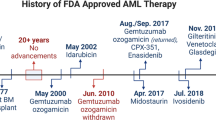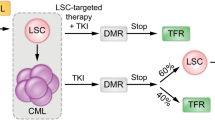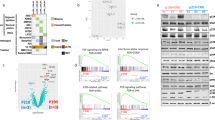Abstract
P38α/β has been described as a tumor-suppressor controlling cell cycle checkpoints and senescence in epithelial malignancies. However, p38α/β also regulates other cellular processes. Here, we describe a role of p38α/β as a regulator of acute lymphoblastic leukemia (ALL) proliferation and survival in experimental ALL models. We also report first evidence that p38α/β phosphorylation is associated with the occurrence of relapses in TEL-AML1-positive leukemia. First, in vitro experiments show that p38α/β signaling is induced in a cyclical manner upon initiation of proliferation and remains activated during log-phase of cell growth. Next, we provide evidence that growth-permissive signals in the bone marrow activate p38α/β in a novel avian ALL model, in which therapeutic targeting can be tested. We further demonstrate that p38α/β inhibition by small molecules can suppress leukemic expansion and prolong survival of mice bearing ALL cell lines and primary cells. Knockdown of p38α strongly delays leukemogenesis in mice xenografted with cell lines. Finally, we show that in xenografted TEL-AML1 patients, ex vivo p38α/β phosphorylation is associated with an inferior long-term relapse-free survival. We propose p38α/β as a mediator of proliferation and survival in ALL and show first preclinical evidence for p38α/β inhibition as an adjunct approach to conventional therapies.
This is a preview of subscription content, access via your institution
Access options
Subscribe to this journal
Receive 12 print issues and online access
$259.00 per year
only $21.58 per issue
Buy this article
- Purchase on Springer Link
- Instant access to full article PDF
Prices may be subject to local taxes which are calculated during checkout





Similar content being viewed by others
References
Moricke A, Zimmermann M, Reiter A, Henze G, Schrauder A, Gadner H et al. Long-term results of five consecutive trials in childhood acute lymphoblastic leukemia performed by the ALL-BFM study group from 1981 to 2000. Leukemia 2010; 24: 265–284.
Locatelli F, Schrappe M, Bernardo ME, Rutella S . How I treat relapsed childhood acute lymphoblastic leukemia. Blood 2012; 120: 2807–2816.
Gandemer V, Chevret S, Petit A, Vermylen C, Leblanc T, Michel G et al. Excellent prognosis of late relapses of ETV6/RUNX1-positive childhood acute lymphoblastic leukemia: lessons from the FRALLE 93 protocol. Haematologica 2012; 97: 1743–1750.
Yasui H, Hideshima T, Ikeda H, Jin J, Ocio EM, Kiziltepe T et al. BIRB 796 enhances cytotoxicity triggered by bortezomib, heat shock protein (Hsp) 90 inhibitor, and dexamethasone via inhibition of p38 mitogen-activated protein kinase/Hsp27 pathway in multiple myeloma cell lines and inhibits paracrine tumour growth. Br J Haematol 2007; 136: 414–423.
Wen J, Feng Y, Huang W, Chen H, Liao B, Rice L et al. Enhanced antimyeloma cytotoxicity by the combination of arsenic trioxide and bortezomib is further potentiated by p38 MAPK inhibition. Leukemia Res 2010; 34: 85–92.
Nijmeijer BA, Szuhai K, Goselink HM, van Schie ML, van der Burg M, de Jong D et al. Long-term culture of primary human lymphoblastic leukemia cells in the absence of serum or hematopoietic growth factors. Exp Hematol 2009; 37: 376–385.
Gaundar SS, Bradstock KF, Bendall LJ . p38MAPK inhibitors attenuate cytokine production by bone marrow stromal cells and reduce stroma-mediated proliferation of acute lymphoblastic leukemia cells. Cell Cycle 2009; 8: 2975–2983.
Cuadrado A, Nebreda AR . Mechanisms and functions of p38 MAPK signalling. Biochem J 2010; 429: 403–417.
Verma A, Deb DK, Sassano A, Uddin S, Varga J, Wickrema A et al. Activation of the p38 mitogen-activated protein kinase mediates the suppressive effects of type I interferons and transforming growth factor-beta on normal hematopoiesis. J Biol Chem 2002; 277: 7726–7735.
Sosa MS, Avivar-Valderas A, Bragado P, Wen HC, Aguirre-Ghiso JA . ERK1/2 and p38alpha/beta signaling in tumor cell quiescence: opportunities to control dormant residual disease. Clin Cancer Res 2011; 17: 5850–5857.
Adam AP, George A, Schewe D, Bragado P, Iglesias BV, Ranganathan AC et al. Computational identification of a p38SAPK-regulated transcription factor network required for tumor cell quiescence. Cancer Res 2009; 69: 5664–5672.
Lu J, Quearry B, Harada H . p38-MAP kinase activation followed by BIM induction is essential for glucocorticoid-induced apoptosis in lymphoblastic leukemia cells. FEBS Lett 2006; 580: 3539–3544.
Zhao YN, Guo X, Ma ZG, Gu L, Ge J, Li Q . Pro-apoptotic protein BIM in apoptosis of glucocorticoid-sensitive and -resistant acute lymphoblastic leukemia CEM cells. Med Oncol 2011; 28: 1609–1617.
Zhou L, Opalinska J, Verma A . p38 MAP kinase regulates stem cell apoptosis in human hematopoietic failure. Cell Cycle 2007; 6: 534–537.
Juarez J, Baraz R, Gaundar S, Bradstock K, Bendall L . Interaction of interleukin-7 and interleukin-3 with the CXCL12-induced proliferation of B-cell progenitor acute lymphoblastic leukemia. Haematologica 2007; 92: 450–459.
Juarez JG, Thien M, Dela Pena A, Baraz R, Bradstock KF, Bendall LJ . CXCR4 mediates the homing of B cell progenitor acute lymphoblastic leukaemia cells to the bone marrow via activation of p38MAPK. Br J Haematol 2009; 145: 491–499.
Drexler HG . Guide to Leukemia-Lymphoma Cell Lines. Electronic Book, DSMZ: : Braunschweig, Germany, 2010, p2.
Nebreda AR, Porras A . p38 MAP kinases: beyond the stress response. Trends Biochem Sci 2000; 25: 257–260.
Kumar S, Jiang MS, Adams JL, Lee JC . Pyridinylimidazole compound SB 203580 inhibits the activity but not the activation of p38 mitogen-activated protein kinase. Biochem Biophys Res Commun 1999; 263: 825–831.
Kuma Y, Sabio G, Bain J, Shpiro N, Marquez R, Cuenda A . BIRB796 inhibits all p38 MAPK isoforms in vitro and in vivo. J Biol Chem 2005; 280: 19472–19479.
Sullivan JE, Holdgate GA, Campbell D, Timms D, Gerhardt S, Breed J et al. Prevention of MKK6-dependent activation by binding to p38alpha MAP kinase. Biochemistry 2005; 44: 16475–16490.
He D, Zhao XQ, Chen XG, Fang Y, Singh S, Talele TT et al. BIRB796, the inhibitor of p38 mitogen-activated protein kinase, enhances the efficacy of chemotherapeutic agents in ABCB1 overexpression cells. PLoS One 2013; 8: e54181.
Carter TA, Wodicka LM, Shah NP, Velasco AM, Fabian MA, Treiber DK et al. Inhibition of drug-resistant mutants of ABL, KIT, and EGF receptor kinases. Proc Natl Acad Sci USA 2005; 102: 11011–11016.
Schreiber S, Feagan B, D'Haens G, Colombel JF, Geboes K, Yurcov M et al. Oral p38 mitogen-activated protein kinase inhibition with BIRB 796 for active Crohn's disease: a randomized, double-blind, placebo-controlled trial. Clin Gastroenterol Hepatol 2006; 4: 325–334.
Aguirre-Ghiso JA, Estrada Y, Liu D, Ossowski L ERK . (MAPK) activity as a determinant of tumor growth and dormancy; regulation by p38(SAPK). Cancer Res 2003; 63: 1684–1695.
Farnoushi Y, Cipok M, Kay S, Jan H, Ohana A, Naparstek E et al. Rapid in vivo testing of drug response in multiple myeloma made possible by xenograft to turkey embryos. Br J Cancer 2011; 105: 1708–1718.
Grinberg I, Reis A, Ohana A, Taizi M, Cipok M, Tavor S et al. Engraftment of human blood malignancies to the turkey embryo: a robust new in vivo model. Leuk Res 2009; 33: 1417–1426.
Dalloul RA, Long JA, Zimin AV, Aslam L, Beal K, Blomberg Le A et al. Multi-platform next-generation sequencing of the domestic turkey (Meleagris gallopavo: genome assembly and analysis. PLoS Biol 2010; 8: e1000475.
Mullighan CG . The molecular genetic makeup of acute lymphoblastic leukemia. Hematol Am Soc Hematol Educ Program 2012; 2012: 389–396.
Linka Y, Ginzel S, Kruger M, Novosel A, Gombert M, Kremmer E et al. The impact of TEL-AML1 (ETV6-RUNX1) expression in precursor B cells and implications for leukaemia using three different genome-wide screening methods. Blood Cancer J 2013; 3: e151.
Zaliova M, Madzo J, Cario G, Trka J . Revealing the role of TEL/AML1 for leukemic cell survival by RNAi-mediated silencing. Leukemia 2011; 25: 313–320.
Hong D, Gupta R, Ancliff P, Atzberger A, Brown J, Soneji S et al. Initiating and cancer-propagating cells in TEL-AML1-associated childhood leukemia. Science 2008; 319: 336–339.
Schindler JW, Van Buren D, Foudi A, Krejci O, Qin J, Orkin SH et al. TEL-AML1 corrupts hematopoietic stem cells to persist in the bone marrow and initiate leukemia. Cell Stem Cell 2009; 5: 43–53.
Fuka G, Kauer M, Kofler R, Haas OA, Panzer-Grumayer R . The leukemia-specific fusion gene ETV6/RUNX1 perturbs distinct key biological functions primarily by gene repression. PLoS One 2011; 6: e26348.
Fuka G, Kantner HP, Grausenburger R, Inthal A, Bauer E, Krapf G et al. Silencing of ETV6/RUNX1 abrogates PI3K/AKT/mTOR signaling and impairs reconstitution of leukemia in xenografts. Leukemia 2012; 26: 927–933.
Kamps MP, Wright DD . Oncoprotein E2A-Pbx1 immortalizes a myeloid progenitor in primary marrow cultures without abrogating its factor-dependence. Oncogene 1994; 9: 3159–3166.
Miller AL, Webb MS, Copik AJ, Wang Y, Johnson BH, Kumar R et al. p38 Mitogen-activated protein kinase (MAPK) is a key mediator in glucocorticoid-induced apoptosis of lymphoid cells: correlation between p38 MAPK activation and site-specific phosphorylation of the human glucocorticoid receptor at serine 211. Mol Endocrinol 2005; 19: 1569–1583.
Heidari N, Miller AV, Hicks MA, Marking CB, Harada H . Glucocorticoid-mediated BIM induction and apoptosis are regulated by Runx2 and c-Jun in leukemia cells. Cell Death Dis 2012; 3: e349.
Lee WH, Liu FH, Lee YL, Huang HM . Interferon-alpha induces the growth inhibition of human T-cell leukaemia line Jurkat through p38alpha and p38beta. J Biochem 2010; 147: 645–650.
Taguchi T, Kiyokawa N, Mimori K, Suzuki T, Sekino T, Nakajima H et al. Pre-B cell antigen receptor-mediated signal inhibits CD24-induced apoptosis in human pre-B cells. J Immunol 2003; 170: 252–260.
Shochat C, Tal N, Bandapalli OR, Palmi C, Ganmore I, te Kronnie G et al. Gain-of-function mutations in interleukin-7 receptor-alpha (IL7R) in childhood acute lymphoblastic leukemias. J Exp Med 2011; 208: 901–908.
Zenatti PP, Ribeiro D, Li W, Zuurbier L, Silva MC, Paganin M et al. Oncogenic IL7R gain-of-function mutations in childhood T-cell acute lymphoblastic leukemia. Nat Genet 2011; 43: 932–939.
Shieh A, Ward AF, Donlan KL, Harding-Theobald ER, Xu J, Mullighan CG et al. Defective K-Ras oncoproteins overcome impaired effector activation to initiate leukemia in vivo. Blood 2013; 121: 4884–4893.
Cui J, Wang Q, Wang J, Lv M, Zhu N, Li Y et al. Basal c-Jun NH2-terminal protein kinase activity is essential for survival and proliferation of T-cell acute lymphoblastic leukemia cells. Mol Cancer Ther 2009; 8: 3214–3222.
Chiarini F, Del Sole M, Mongiorgi S, Gaboardi GC, Cappellini A, Mantovani I et al. The novel Akt inhibitor, perifosine, induces caspase-dependent apoptosis and downregulates P-glycoprotein expression in multidrug-resistant human T-acute leukemia cells by a JNK-dependent mechanism. Leukemia 2008; 22: 1106–1116.
Scupoli MT, Donadelli M, Cioffi F, Rossi M, Perbellini O, Malpeli G et al. Bone marrow stromal cells and the upregulation of interleukin-8 production in human T-cell acute lymphoblastic leukemia through the CXCL12/CXCR4 axis and the NF-kappaB and JNK/AP-1 pathways. Haematologica 2008; 93: 524–532.
Leung KT, Li KK, Sun SS, Chan PK, Ooi VE, Chiu LC . Activation of the JNK pathway promotes phosphorylation and degradation of BimEL—a novel mechanism of chemoresistance in T-cell acute lymphoblastic leukemia. Carcinogenesis 2008; 29: 544–551.
Forestier E, Heyman M, Andersen MK, Autio K, Blennow E, Borgstrom G et al. Outcome of ETV6/RUNX1-positive childhood acute lymphoblastic leukaemia in the NOPHO-ALL-1992 protocol: frequent late relapses but good overall survival. Br J Haematol 2008; 140: 665–672.
Acknowledgements
DMS and SL are supported by the Max-Eder group leader program by the Deutsche Krebshilfe e. V. DMS is supported by the Translational Research Training in Hematology Program 2014 by EHA and ASH. SL is further supported by the Deutsche Forschungsgemeinschaft (DFG), the Roggenbruck Stiftung, the Hamburger Krebsgesellschaft, the Medical Faculty of the University of Hamburg (FFM program) and the Hamburger Exzellenzinitiative (LEXI program). MC is supported by the Alexander von Humboldt Stiftung. IJ is supported by the Deutsche Forschungsgemeinschaft (SFB684, TP22) and the German José Carreras Leukemia Foundation (R10/26). JAA-G is supported by the Samuel Waxman Cancer Research Foundation Tumor Dormancy Program and NIH/National Cancer Institute grants (CA109182 and CA163131). We thank Katrin Timm-Richert, Katrin Neumann, Annika Brauer and Christian Bretscher for excellent technical assistance.
Author Contributions
DMS initiated, designed and supervised the research, analyzed the data and wrote the manuscript. SS and AA designed and performed experiments and analyzed the data. SK helped performing the experiments. CV performed the experiments and analyzed the data. MC and IJ contributed important constructs and professional expertise to the project. SL, GC, AT, JAA-G, M Stanulla and M Schrappe commented and discussed the research direction and edited the manuscript. All authors discussed the manuscript.
Author information
Authors and Affiliations
Corresponding author
Ethics declarations
Competing interests
The authors declare no conflict of interest.
Additional information
Supplementary Information accompanies this paper on the Leukemia website
Rights and permissions
About this article
Cite this article
Alsadeq, A., Strube, S., Krause, S. et al. Effects of p38α/β inhibition on acute lymphoblastic leukemia proliferation and survival in vivo. Leukemia 29, 2307–2316 (2015). https://doi.org/10.1038/leu.2015.153
Received:
Revised:
Accepted:
Published:
Issue Date:
DOI: https://doi.org/10.1038/leu.2015.153
This article is cited by
-
Involvement of the central nervous system in acute lymphoblastic leukemia: opinions on molecular mechanisms and clinical implications based on recent data
Cancer and Metastasis Reviews (2020)
-
Synergism between IL7R and CXCR4 drives BCR-ABL induced transformation in Philadelphia chromosome-positive acute lymphoblastic leukemia
Nature Communications (2020)
-
Time dependent response of daunorubicin on cytotoxicity, cell cycle and DNA repair in acute lymphoblastic leukaemia
BMC Cancer (2019)



